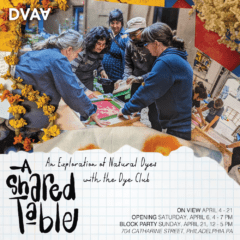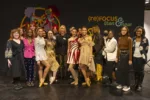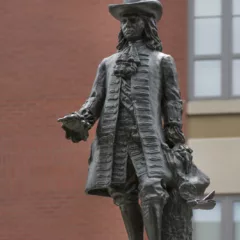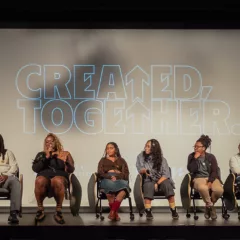(Rachel is excited about the new exhibit at PAFA that celebrates the city’s painted walls, and she wishes the show could have covered even more territory about murals and placed Philadelphia’s mural movement in a national context.–the Artblog editors)
Here is a small secret I don’t let many in on: I moved to Philadelphia because of the murals. Since my undergraduate days memorizing the names and dates of Mexico’s iconic walls, the vast community of muralists and public art scholars has been whispering Philadelphia into my ears. Philadelphia’s reputation as a mural mecca is unequivocal – a reality that a simple stroll around the city will confirm instantaneously.
The vibrancy of murals and the 30th anniversary of the Mural Arts Program
Beyond the Paint: Philadelphia’s Mural Arts on view at the Pennsylvania Academy of the Fine Arts captures the vibrancy, ingenuity and perseverance of the Mural Arts Program. Organized in celebration of Mural Arts’ 30th anniversary, the exhibition focuses on the archive, presenting documents of the organization in testimony, photographs, installation and video footage. Open through April 6, 2014, the exhibition could easily be a permanent one.
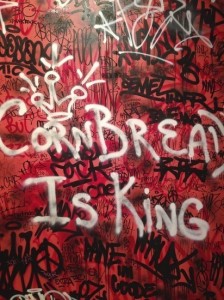
The show opens with a wall covered in tags. Cornbread – the Philadelphian often regarded as the “father of modern graffiti” – takes his place in the center of the panel. The reference goes back to Mural Arts’ 1984 origins as the Philadelphia Anti-Graffiti Network (PAGN), when Director Jane Golden was hired to teach visual art to taggers in order to create new channels for creative aesthetic expression (and clean up city walls).
This history is compellingly narrated. Newspaper clippings from the Philadelphia Inquirer and old photographs of artists at work on scaffolding provide a keen sense of time. The archival footage is fantastic, especially a 1994 interview with community leader Rachel Bagby who states that “The murals bring history a little closer,” both teaching children and awakening adults. In another video from the 1980s Golden discusses the problem of the city’s vacant buildings and the impact of murals on the urban landscape – an issue that remains critical thirty years later.
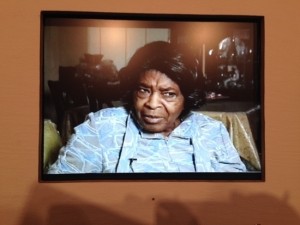
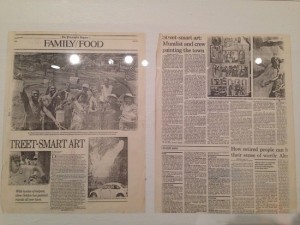
Pivotal moments – “Picturing Philadelphia” and “We are Here”
Following the origins section, the exhibition explodes – a new pop of color meeting the eye with each step through the space. Divided into core themes that are central to Mural Arts’ work, the show becomes a retrospective of pivotal moments in the organization’s history. Neighborhoods are the focus in “Picturing Philadelphia,” which pays special attention to Mantua in West Philly, where murals have played an active part in enabling space for community dialogue and collective memory.
In “We are Here,” the focus is identity, showcasing projects that engage themes such as immigration, gentrification, and community formation. They include Building Connections (2007), Journey’s South (2011), and Heart of Baltimore Avenue (2008).
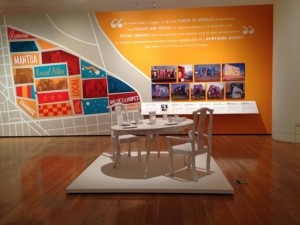
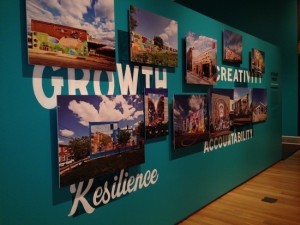
Southeast by Southeast (2013), an in-progress mural dedicated to immigrant and refugee families from Southeast Asia led by artists Miriam Singer and Shira Walinsky includes a studio space in the gallery devoted to chronicling the mural’s development – the walls covered with photographic portraits and brightly-hued textiles. A table displays index cards with prompts for visitors, including: “I like life in the United States because…;” “Life in the United States is hard because…” The contrasting answers provide a glimpse into immigrant life that will eventually find their place in the mural itself.
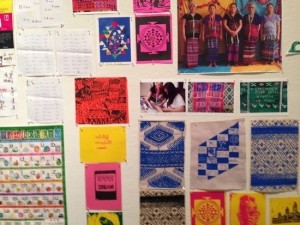
Pivotal moments – “Healing Walls” and “Bearing Witness”
In “Healing Walls” and “Bearing Witness,” the organization’s Restorative Justice program is at the forefront, along with mural projects like Pride and Progress (2002) that engage with topics of discrimination against Muslims and the LGBT community. A close examination of Peace Wall (1997), in which hands of various ages, genders and races come together in unity on a public wall in Grays Ferry, emphasizes the debate that often surrounds a mural’s design. Video footage shows community members discussing which images could successfully bridge the racial divisions that defined the neighborhood.
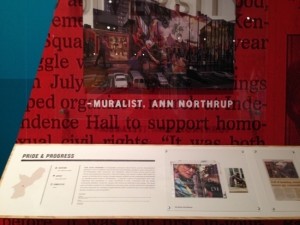
The process of creation revealed
Beyond the Walls also dives into the creation process, providing examples of mural techniques like mosaics and murals created off-site via parachute cloth. It also explores educational initiatives and recent collaborations with individual artists, cultural organizations and civic institutions that often diverge from the traditional mural model. This includes What We Sow (2013) in which Mural Arts collaborated with artists Lucy + Jorge Orta to organize a communal meal on the streets of Center City. The event engaged citizens and civic leaders in a public discussion about local food production, health and sustainability.
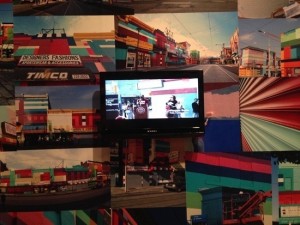
The highlights – a reference library, broadsheets for the neighborhoods and Megawords
The show’s highlights are the collaborative, site-specific installations that underscore the participatory and the performative.
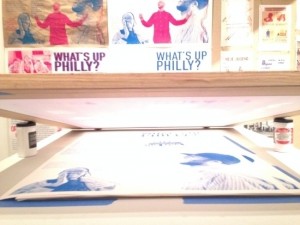
New York-based artist Josh MacPhee set up a temporary screen-printing shop for broadsheet production. The collaboratively-designed broadsheets will chronicle local communities through narratives, poetry and drawing which will then be posted throughout the city. While its success is not yet cemented, the concept is full of potential. The broadsheet has a deep connection with the history of mural painting; caricaturist José Guadalupe Posada and his famous calaveras were among the central inspirations for the murals of Revolutionary Mexico. Connecting this legacy with a contemporary interpretation of broadsheet production is brilliant.
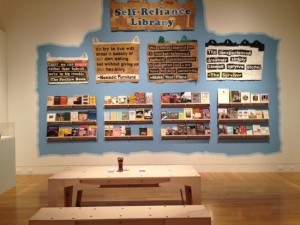
The artist collective Temporary Services created a “Self-reliance Library” especially for the exhibition. The library features sixty books that are “designed to provoke the reader, solve creative problems, or suggest imaginative directions for a range of creative practices.” The installation invites viewers to choose a piece of literature, open its pages, and engage. Included are books dedicated to cycling, tree houses, and even Paul Klee’s hand puppets.
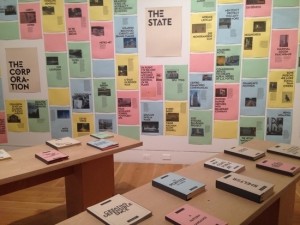
The final installation is by Philadelphia artist duo Megawords (Dan Murphy and Anthony Smyrski). Occupying the far corner of the gallery, pastel-colored sheets document historical and contemporary interventions in public space. The sheets are affixed to the wall, divided into their respective ‘actors’: corporations, the state, individuals and institutions. Examples range from Smog Free Hong Kong and the Berlin Wall to Watts Tower and Storm King. The documentation is paired with foundational texts on public art theory, offering examples of the myriad methods of engaging with public space through imaginative means.
The inclusion of these three installations accentuates Mural Arts’ intention to present itself as an organization embedded within the discourse and historical development of social practice art, and is emblematic of the organization’s constant eye to the future. The installations add layers of dimensionality to a show that otherwise could have fallen into the trap of a monotonous survey.
A huge show with good messages and massive wall texts to read
Overall, the exhibition is giant and extensive. Considering it is a show about an organization that has produced over 3,600 murals, the curators did a remarkable job of condensing the years of output into a coherent narrative. While every mural holds value, the ones chosen for the exhibition offer a well-rounded and thoughtful look at the themes, spaces and tensions embedded within the paint.
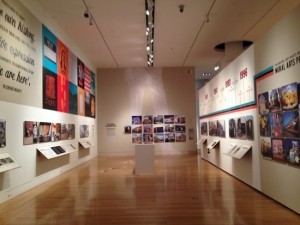
Where the show needs editing, however, is in its language. The large and frequent blocks of text, while certainly informative, are often repetitive and long-winded. The constant refrain that murals “generate unity,” “transform neighborhoods,” and “provide tools for healing” loses its power when repeated too often, sounding like an amiable add-on rather than the urgent statement that it is.
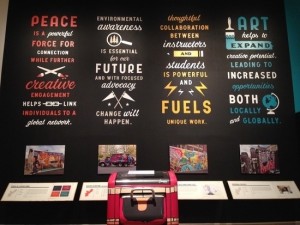
Nevertheless, the show will leave you awed at Mural Arts’ vibrancy, influence and momentum. The spirit of the organization and its many collaborations is celebrated, capturing the joy that Mural Arts exudes and its dedication to Philadelphia. For those new to public art, especially mural painting technique and process, it is an informative and eye-opening show. And for students and teachers, Beyond the Paint will act as a great educational tool that will surely foster the next generation of Philadelphia muralists.
That said I wished the show had dug even deeper and looked beyond Philadelphia. The significance of the Mural Arts Program is both huge and complex and it deserves a critical look at its place within the larger history of community mural movements and social practice art. Where is the Mural Arts Program’s place within the larger discourse of mural-making? How has MAP responded to or engaged with the pioneering community mural movements in Chicago, Los Angeles and San Francisco? Why is it that more murals exist in Philadelphia than in any other city in the world? Where has it borrowed from? Where does it innovate?
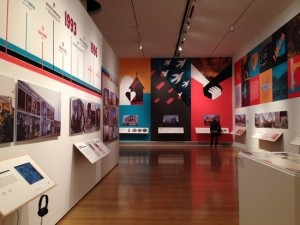
Perhaps those questions are still being answered – or perhaps they comprise a completely different exhibition. With an extensive series of events and public discussions surrounding the show, I hope that the opportunity to engage further is enabled. So while Beyond the Paint is beautifully executed and impactful, it left me eager to peel back the layers even further.
Beyond the Paint is on view at PAFA through April 6, 2014. Free admission on Sundays.
All photos courtesy of the author.



